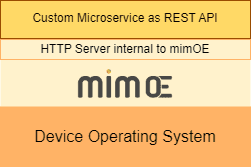- Introduction to mim OE
- How Does the mim OE Runtime Work?
How Does the mim OE Runtime Work?
The mim OE Runtime is a binary executable that runs as a process on all devices running within a mim OE cluster. In fact, by definition, for a device to be considered a member of a mim OE cluster, it must be running the mim OE Runtime.
Once the mim OE Runtime process is up and running, it acts as an intermediary serverless runtime between a custom microservice and the host device's operating system. (See Figure 1 below.)

|
|---|
| Figure 1: mim OE interacts with the host operating system to provide a serverless environment upon which to run a custom microservice |
The mim OE Runtime has its own internal HTTP server that supports custom microservices. These microservices are created using the mim OE. (We'll discuss the mim OE further along in this introductory documentation.) A microservice is exposed to the cluster as a RESTful API.
In addition to providing the serverless runtime environment, the mim OE Runtime takes care of all the work that adds the device to a mim OE cluster as a fully functional node accessible by other devices within the cluster.
In effect, once the mim OE Runtime is installed on a device, that device is transformed into a node in a mim OE cluster.
That node can now run a microservice in a serverless manner. That microservice is created using the mim OE . Also, once the microservice is up and running on a device, it can be used by another device within the mim OE cluster.